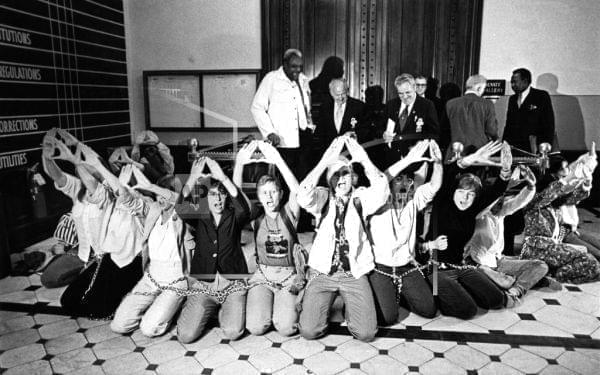Illinois, which buried ERA decades ago, now its darling

In this June 3, 1982 file photo, a group of feminists chained themselves together outside the Illinois Senate chambers in Springfield, Ill., to show support for the ratification of the ERA The women chanted and held their hands in the shape of a womb to symbolize womanhood. Illinois for decades remained the only industrial northern state not to ratify the federal Equal Rights Amendment. But decades after the Congressional deadline the state finally approved the resolution AP Photo / File
In 1981, dozens of women descended upon the Illinois state Capitol with bread and other baked treats for legislators. On the annual “Stop-ERA Bread Day,” their message: Men who approve the Equal Rights Amendment can no longer count on their wives to tend to hearth and home.
Their leader, a housewife from Alton named Phyllis Schlafly, railed against the ERA to guarantee equal rights for women, saying it would lead to taxpayer-funded abortions and forced military draft for women. Schlafly was credited with stopping ERA’s momentum, which was all but declared dead when Illinois failed to ratify it in 1982, the year Congress had set as a deadline.
But decades later, after scores of shattered glass ceilings in politics, government, business and media, and an amped-up crackdown on sexual harassment, Illinois became the 37th state to ratify ERA last month. If a 38th state follows, supporters will push to add the amendment to the U.S. Constitution, likely setting off a flurry of legal arguments over whether the 1982 deadline holds.
What changed? Both advocates and critics agree that fallout from the anti-sexual harassment campaign known as #MeToo spawned an uprising of politically energized young women who know mistreatment and workplace discrimination. It helped them understand, said Carol Robles-Roman, co-president and CEO of the New York-based national ERA Coalition, “that women need these protections and what’s currently in place isn’t enough.”
But there was more at play in Illinois, namely the composition of the legislature. Today, Democrats are riding a 15-year lock on control of the General Assembly. In 1982, the ERA’s House passage was blocked by Republican Speaker George Ryan, the future governor whose hard line on civil rights softened in later years.
And although it took longer than expected, the seeds of Illinois ratification were planted even before the federal ERA was proposed. Illinois included an Equal Rights Amendment to its own constitution, which voters adopted in 1971.
“People saw the state had not gone to hell in a hand basket,” said Democratic House Majority Leader Barbara Flynn Currie of Chicago. “That made people understand that the ratification of the ERA was not likely to lead to cataclysmic changes in the United States.”
Currie, who entered the House in 1979, agreed that #MeToo spurred action, because it drove home “that women are not being given full and equal authority — even though we may have the law on our side” along with men at work and elsewhere.
Critics don’t dismiss #MeToo’s influence. In the eyes of Elise Bouc, state chairwoman of Stop ERA Illinois, the movement created an “emotionally charged atmosphere,” that blinded younger women into supporting an amendment they don’t understand. As to that atmosphere, Bouc said, “The supporters of the ERA fueled that.”
While the amendment would make gender a legally protected class like religion or race, making it easier to file lawsuits over discrimination, Bouc believes women and men should not be treated the same inasmuch as lawmakers must account for biological differences when considering, for example, pregnancy accommodations.
Nevada, which ratified the amendment in spring 2017, joins Illinois as a state adopting the amendment after Republican President Donald Trump took office. But activists of all stripes are reluctant to say that he had much of an impact on its revival, mainly because the amendment has never been a truly partisan issue.
Congress overwhelmingly approved the ERA on March 22, 1972. Hawaii ratified it the same day, followed quickly by dozens of states by the mid-1970s. In Illinois, it was a conservative, Republican Rep. Susan Catania of Chicago, who championed the ERA cause.
Schlafly’s daughter, Anne Cori Schlafly, who now heads her late mother’s interest group Eagle Forum, agrees that post-Trump activism isn’t surprising. She said that, thanks to her mother, it cuts on both sides of the ERA debate.
“Women who never had before engaged themselves in politics or in the public sphere were energized and motivated and inspired by her,” Cori Schlafly said.

